|
World
War One and Later Car production continued
throughout much of the war, although some war work was
undertaken, including the machining of shell cases.
Briton also became the UK agent for the American
Scripps-Booth light car, but the venture failed. |
| |
|
View the 1914 and
1915 models. |
 |
| |
|
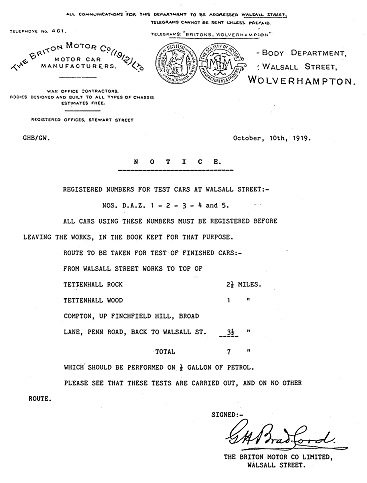 |
This notice
was issued by the Company in 1919 to all test
drivers. It gives the route over which the cars were
tested.
They started
from Lower Walsall Street works, went to the top of
Tettenhall Rock, through Tettenhall Wood to Compton,
up Finchfield Lane, along Broad Lane, and the Penn
Road, and back to Lower Walsall Street.
This was a
total of 7 miles "which should be performed on 1/2
gallon of petrol".
Courtesy of
the late Charles Weight.
|
| In 1917 and 1918 only small commercial vans and
ambulances were produced. The models included the
following: 5 cwt. 10/12hp. 2 cylinder, 98mm bore x 120 mm
stroke, 1,000 r.p.m. Selling price 155 guineas.
7 cwt. 10/12hp. 4 cylinder, 68mm bore x 120 mm
stroke, 1,000 r.p.m. Selling price 185 guineas.
15cwt. 10/12hp. 4 cylinder, 80mm bore x 120 mm
stroke, 1,000 r.p.m. Selling price 220 guineas.
The company also made a 50cwt
commercial vehicle powered by a Dorman engine. Only a
five were built.
|
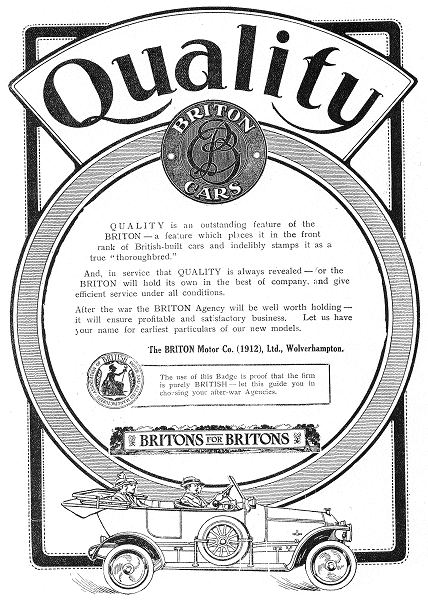
An advert from 1917.

An advert from 1917.
| Briton 14 hp., 4 cylinder, 15
cwt., prototype Red Cross Ambulance.
This photo was taken outside the
Briton factory.
Courtesy of the late Charles Weight. |
 |
|
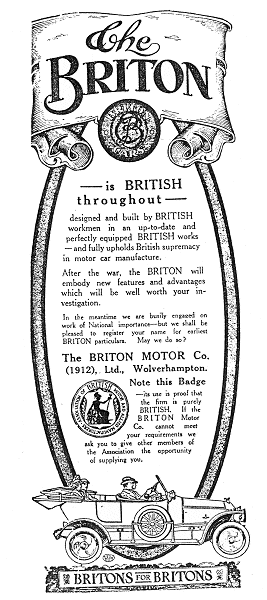 |
Unfortunately the company found
itself in trouble with the government because it had
failed to meet all of its contractual obligations. As a
result the government demanded financial compensation.
This resulted in a call for shares of £50,000. Production resumed in 1919 with
the launch of the 10/12hp. car, powered by a 4 cylinder,
1,375c.c. engine with a 63mm bore and a 110mm stroke. It sold for 420 guineas. A total of 106 were
produced in that year along with 549 of the 14/16hp.
cars.
The company also raised £50,000 from an issue of
shares. In 1920 three new models were designed including
a Chapuius Dornier engined sports car, but never went
into production.
During the year a total of 170 cars were built at the
works; 163 of the 10/12hp. model and 7 of the 10hp.
model. By this time the larger car manufacturers such
as Austin and Morris had adopted mass production
techniques and were selling their cars for as little as
£100.
Briton could not compete in this market and was in
deep financial trouble.
In December 1920 the Midland Bank took £50,000 of
debenture stock, and during 1921 only sixty five 10/12hp. cars
were built.
A wartime advert. Courtesy of
the late Charles Weight. |
|
In December of that year the bank appointed
a receiver; Harold Jeddon, F.C.A., of Muras, Harries,
Johnston & Company, chartered accountants.
A month later a liquidator was appointed, the value
of the company being assessed at £30,500.
On 15th February, 1922 the buildings and contents
were auctioned by Boswell & Tomlins at the Star and
Garter Hotel. The factory was sold to A. J. Stevens & Company (1914) Limited for
£7,000. |
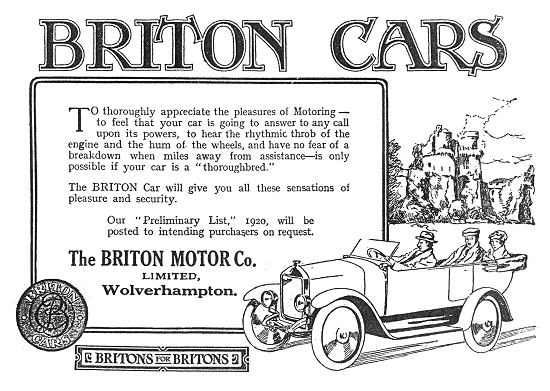
An advert from 1920. Courtesy of
the late Charles Weight. |

The front of the sale catalogue.
 |
Briton's chief tester, Mr. J.
W. T. Trusselle, in a 1922 11.9hp. four cylinder,
standard 2 seater.
Courtesy of the late Charles Weight.
|
| Mr. Trusselle again, this time
in a 1922 11.9hp. 2 seater, de luxe, with dual purpose
head and side-lights, 3 wheel stud and dowel fittings,
bull nosed radiator. Mr.
Trusselle later started a garage in Newhampton Road,
Wolverhampton.
Courtesy of the late Charles Weight. |
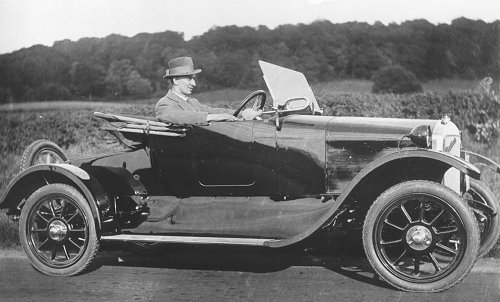 |
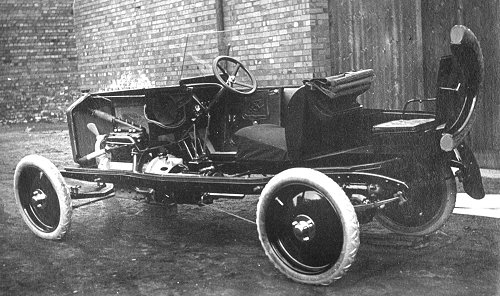 |
A 1922 four cylinder sports
model with dickey and hood. Cut away for exhibition
purposes. Courtesy of
the late Charles Weight. |
| Another employee, Mr. Jack
Handley, the company's designer and draughtsman.
He is in his own 1929
15.9hp. Briton, produced at Chillington Fields.
Courtesy of the late Charles Weight. |
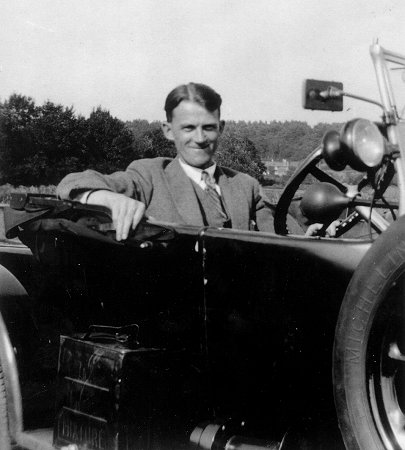 |
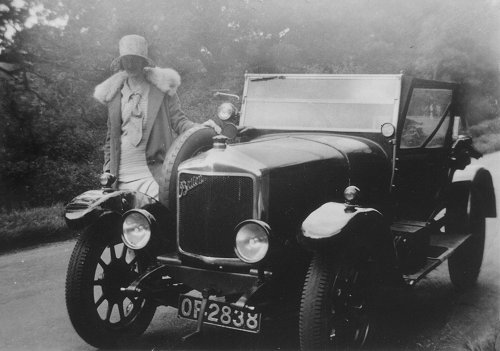 |
Another view of Jack Handley's
15.9hp. car and his wife.
Courtesy of the late Charles Weight. |
A final view of Jack Handley's 15.9hp. car and
his wife.
Courtesy of the late Charles Weight.
|
 |
| Rebirth - by the late Charles G. Weight It was at this time, in 1922, that my father,
Charles A. Weight, took over The Briton Motor Co. and moved the
machine shop (all the machines were belt driven from overhead
pulleys and shafting driven by D.C. electric motors); some ten to
fifteen 2 cylinder cars, now far out of date; and a large quantity
of forgings, castings and finished components to his premises at
Chillington Fields. A number of the workforce also moved the half
mile to Chillington Fields. |

Mr. W. H. Bradford, the last
Managing Director of
the Briton Motor Co. He lived in Pennhouse Avenue.
Courtesy of the late Charles Weight. |
Production continued until 1924 but only with
the 4 cylinder 10/12hp. and the 14/16hp. models. Several
improvements were required to match the competition. As car
components became more costly and the company ran out of stocks, car
production ceased in 1929, a total of about 600 cars having been
made at Chillington Fields.
The Briton Motor Company, under my father, took
on machining for other companies, which included Holt 2 and 5 ton
Lower Rollers for the London agent, Tractor Traders Ltd., and
tractor spare parts for local contractors.
In 1940 The Briton Motor Co.
changed its name to Tractor Spares Limited, a company
which survived the Second World War, slumps and
recessions, became an international player and still exists today.
|
| |
|
| The Black Country Living
Museum's 1914 Briton 10/12 hp. 4-cylinder, Special Car
with a streamlined body has recently been restored. Read
about the restoration and the people involved. |
 |
| |
|
Into Preservation
As far as is known only 12 Briton cars still exist.
They are as follows:
|
Year |
Model |
Location |
| 1909
|
10hp. 2-cylinder |
unknown |
| 1910
|
10hp. Little Briton |
Matlock, Derbyshire |
| 1910
|
10hp. Little Briton |
Palmerston, New Zealand |
| 1910
|
10hp. Little Briton |
Hobsonville, New Zealand |
| 1910
|
12hp. Little Briton |
Skipton, Yorkshire |
| 1911
|
14hp. 4-cylinder |
Benalla, Victoria, Australia |
| 1912
|
14hp. 4-cylinder |
Benalla, Victoria, Australia |
| 1912
|
14hp. 4-cylinder |
Toorak, Victoria, Australia |
| 1912
|
11.3hp. 4-cylinder |
Wolverhampton |
| 1913
|
14/16hp. 4-cylinder |
Booragoon, Western Australia |
| 1913
|
10hp. 4-cylinder |
Ash Martock, Somerset |
| 1914
|
4-cylinder |
Black Country Living Museum, Dudley |
|
I would like to thank the late Charles Weight, and David Evans of the Star, Starling, Stuart & Briton
Register for their help in producing this section.. |
 |
|
 |
Return to
the beginning |
|
Return to the list
of manufacturers |
|